
News |
- Save the Bees - Sign the Petition!
- Canada Has New Environment Minister
- Cross Breeding Threatens Arctic Species
- Poplar River Plan Posted With No Notice
- Wall Could Block East Side Beaches
- Canada: Climate Change Laggard
- Mackenzie Pipeline Approved
- Royal Society of Canada Oilsands Report
- Manitoba Corporate Welfare for Tembec
- Canadian Environment Commissioner says Environmental Issues Hindered
- Polar Bears Starving to Death in Hudson Bay
- Cancún Creates Hope for Durban
| Save the Bees - Sign the Petition! | 11 January 11 |
 A global petition is hoping to convince the US and EU to follow France, Italy, Slovenia, and Germany by banning neonicotinoid pesticides.
A global petition is hoping to convince the US and EU to follow France, Italy, Slovenia, and Germany by banning neonicotinoid pesticides.Neonicotinoids ("new nicotine-like things") are among the most widely used insecticides, and are used predominantly to coat seeds. Neonicotinoids persist in the soil, can harm airborne insects, soil organisms, and waterborne insects. Neonicotinoids are "systemic", which means that they do not simply sit on the plant's surface but are taken up into the plant, so the plant become toxic to feeding insects. Unfortunately, neonicotinoids are present in the pollen and nectar of flowers fed on by honeybees. Leaked U.S. Environmental Protection Agency (EPA) memos reveal the agency gave conditional approval to Clothianidin, a neonicotinoid based pesticides now in wide use, without requiring adequate proof that the chemical was safe to use around honeybees. EPA gave conditional approval in 2003, and allowed the chemicals to be sold, but told the manufacturing company, Bayer Crop Science, they needed to complete further safety testing regarding safety of use around honeybees. Bayer failed to do the testing for years, and instead sought and received an extension of the conditional permit to use the chemical. When Bayer finally performed the study, several deficiencies in conduct of the study were identified. EPA deemed the defective study acceptable and gave full registration to clothianidin in 2007. Globally bee numbers have been on the decline in recent years, with beekeepers losing 30 to 90% of their hives since 2006. This phenomenon is dubbed Colony Collapse Disorder (CCD). Multiple scientific studies identify neonicotinoids as contributing factor. Bees pollinate 90% of the plants we grow and deliver an estimated $40 billion in annual pollination services. European countries with neonicotinoids bans have seen improvements in bee populations. Sign Avaaz.org PetitionView November 2, 2010 EPA leaked Memo (PDF) View December 10, 2010 Fast Company article View December 14, 2010 Fast Company article View January 7, 2010 CommonDreams.org article View January 8, 2010 Huffington Post article View Manitoba Wildlands Biodiversity & Species page Sources: CommonDreams.org, EPA, Avaaz |
|
 Print version Print version |
Top |
| Canada Has New Environment Minister | 10 January 11 |
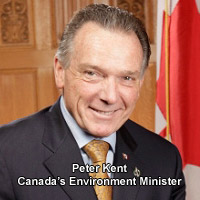 Peter Kent, a former TV journalist and Toronto area MP since 2008, was appointed Canada's new Environment Minister in the January 4, 2011 cabinet shuffle. Kent replaces John Baird who filled in as interim Environment Minister after then Environment Minister Jim Prentice quit politics in November 2010, before going to a job at the Canadian Imperial Bank of Commerce.
Peter Kent, a former TV journalist and Toronto area MP since 2008, was appointed Canada's new Environment Minister in the January 4, 2011 cabinet shuffle. Kent replaces John Baird who filled in as interim Environment Minister after then Environment Minister Jim Prentice quit politics in November 2010, before going to a job at the Canadian Imperial Bank of Commerce."My objective is to fit into the big boots left by Jim Prentice and John Baird," said Kent, adding, "I'm not going to stand by while outsiders slander Canada, Canadian practices and values and our ethical oil products. Communications is going to be a big part of my job." Mr. Kent is the fifth Environment Minister in fiver years. Ed Whitingham, newly appointed director of the Pembina Institute, issued the newly minted minister with a list of New Year Resolutions for Minister Kent:
Green Party Leader Elizabeth May stated, "Peter Kent will not do anything different. He was hired for his communications skills to skate around Canada's continuing sabotage of the climate process." "We need an advocate in this government. It would be very disappointing and distressing to learn that right at the beginning that Mr. Kent has no ambition to improve what's generally seen as a failed ministry at this point," said Liberal Environment Critic Gerrard Kennedy. "Peter Kent has very little experience in public administration and none whatsoever in the environment. Environment remains an extremely important portfolio for the future. We have moral, ethical and legal responsibilities towards future generations," said NDP Deputy Leader Thomas Mulcair. View January 4, 2011 Pembina Institute BlogView January 4, 2011 CTV coverage View January 4, 2011 Calgary Sun article View January 4, 2010 CBC blog View January 5, 2011 Ottawa Citizen article View January 6, 2011 CBC Power and Politics transcript (DOC) View January 6, 2011 Winnipeg Free Press article View January 7, 2011 Calgary Sun article View January 7, 2011 Tyee article View January 9, 2011 North Shore News View January 10, 2011 CTV article Sources: CTV, Ottawa Citizen, Pembina Institute, CBC |
|
 Print version Print version |
Top |
| Cross Breeding Threatens Arctic Species | 8 January 11 |
 Two grizzly-polar bear hybrids discovered in Canada's North may be only the tip of an 'iceberg' that threatens to sink arctic biodiversity. At least 22 species -- many of them threatened or endangered -- are at risk of hybridizing in 34 combinations according to a December 2010 study published in Nature, conducted jointly by the National Oceanic and Atmospheric Association (NOAA), the University of Alaska, and the University of Massachusetts. Authors of the study advise that if stringent monitoring of all at-risk populations is not implemented soon, many discrete populations will disappear.
Two grizzly-polar bear hybrids discovered in Canada's North may be only the tip of an 'iceberg' that threatens to sink arctic biodiversity. At least 22 species -- many of them threatened or endangered -- are at risk of hybridizing in 34 combinations according to a December 2010 study published in Nature, conducted jointly by the National Oceanic and Atmospheric Association (NOAA), the University of Alaska, and the University of Massachusetts. Authors of the study advise that if stringent monitoring of all at-risk populations is not implemented soon, many discrete populations will disappear.If greenhouse gas emissions continue at current rates, scientist predicts that the Arctic Ocean could be completely free of permanent sea ice. The sea ice acts as a barrier which separates many marine mammal populations. With the loss of the ice, populations which have been isolated from each other for millennia could potentially interbreed. This could result in the disappearance of unique, adaptive characteristics. "By melting the seasonal ice cap, we're speeding up evolution. People often talk about species adapting to climate change, but the kind of adaptation that's necessary is a change toward genes that fit the new climatic environment better than the old genes. Individuals don't adapt genetically. Populations do. That requires generations, which requires time. But we're talking about losing the Arctic summer sea ice in a matter of a few decades. So the time for adaptive response may not be there," lead author and NOAA scientist Brendan Kelly told OnEarth.org. View December 22, 2010 Mongabay.com articleView December 16, 2010 Nature article (PDF) View December 16, 2010 Nature supplementary information (PDF) View December 16, 2010 Alaska Dispatch article View December 15, 2010 CBC News article Source: Nature |
|
 Print version Print version |
Top |
| Poplar River Plan Posted With No Notice | 4 January 11 |
 In October, 2010 Manitoba Conservation announced that it would be posting the first lands plan from a First Nation involved in the future world heritage site on Manitoba's east side. That announcement was in relation to the new legislation regarding the east side, The East Side Traditional Lands Planning And Special Protected Areas Act.
In October, 2010 Manitoba Conservation announced that it would be posting the first lands plan from a First Nation involved in the future world heritage site on Manitoba's east side. That announcement was in relation to the new legislation regarding the east side, The East Side Traditional Lands Planning And Special Protected Areas Act.Since then communities and interested stakeholders have watched for the posting of the Poplar River First Nation Lands Plan, Asatiwisipe Aki Management Plan. As of January 4, 2011 the plan is searchable on the Manitoba government web site. Unfortunately there is no web page location, no press release or notification, no information as to review or providing comments, no public registry in place. A similar problem occurred in November 2010 with a non survey for the planning area with respect to this Act. What is available is officially noted as not being a survey, and was only available some days after the planning area regulation - which listed the survey. "The question to ask in this situation is whether or not our government is serious about protecting the east side, and serious about supporting community driven lands plans for traditional lands. Perhaps the same question applies to the future world heritage site. And existing concerns about access to information and public reviews in Manitoba simple multiply when this happens," commented Gaile Whelan Enns. Full details as to notification, posting, timelines, review and public comments for review of lands plans from East Side First Nations will be, presumably, put in place immediately. View December 2010, Poplar River First Nation, Asatiwisipe Aki Management Plan (PDF)View October 25, 2010 Government of Manitoba press release View June 4, 2009 & June 8, 2009 Manitoba Hansard, Standing Committee on Legislative Affairs View June 11, 2009 Manitoba Hansard, House Debates View Manitoba East Side Traditional Lands Planning And Special Protected Areas Act View Poplar River First Nation "Lands Management Plan" page View Manitoba Wildlands "Manitoba World Heritage Site" page View Manitoba Wildlands "East Side Planning Initiative" page View November 2010 Manitoba Wildlands work product "Public Registry Assessment" (PDF) View Pimachiowin Aki World Heritage Project Source: Manitoba Government |
|
 Print version Print version |
Top |
| Wall Could Block East Side Beaches | 4 January 11 |
 The first step of a controversial plan to build a 11 meter (36 ft) wide angled wall of boulders along the length of King Edward and Alexander beaches on the east side of Lake Winnipeg was approved 3-2 by the Rural Municipality (RM) of Victoria Beach December 20, 2010.
The first step of a controversial plan to build a 11 meter (36 ft) wide angled wall of boulders along the length of King Edward and Alexander beaches on the east side of Lake Winnipeg was approved 3-2 by the Rural Municipality (RM) of Victoria Beach December 20, 2010.A public meetings will be held in Winnipeg on January 12 from 7 - 9 p.m at Fort Garry United Church, located at 800 Point Road. Another public meeting will be booked for the Victoria Beach area. The RM approval allows an engineer to begin preliminary planning for the wall. Then the proposal will be submitted to Manitoba's Shoreline Erosion Technical Committee for review and recommendations. The proponents want to start work in January and be finished by April. Lake Winnipeg's shorelines suffered severe erosion following an October 27, 2010 weather bomb that caused winds of more than 90 kilometres per hour over Lake Winnipeg. With already high moisture levels and flooding expected in Spring 2011 some lakefront cottage owners are concerned about potential erosion of their properties and are pushing for the wall. Other residents are concerned about impacts the wall will have on the heavily used public beaches, and that the proposal is being hastily approved without adequately consulting the public. "I believe we need a plan [for shoreline erosion], but I don't believe this [the wall proposal] is it. If we allow this to go on, we may lose the beach," said RM of Victoria Beach councillor Kathy McKibbin who voted against the proposal. "People don't want to come to the beach in the summer and be gobsmacked with the construction," said RM Councillor Karen Boyd, who also then voted for the proposal on December 20th. Reeve Tom Farrell, who voted in favour of the proposal on December 20th, indicated that the RM cannot always be asking for public input, which in this case could delay construction for a year. "Some of these decisions are not always pleasant," Farrell said. View December 20, 2010 Winnipeg Free Press articleView December 21, 2010 Winnipeg Free Press article View December 22, 2010 RM of Victoria Beach, Notice of Shoreline Protection Informational Meeting (PDF) View December 26, 2010 Winnipeg Free Press Letter to the Editor View Shoreline Erosion Technical Committee page Source: Winnipeg Free Press, RM of Victoria Beach |
|
 Print version Print version |
Top |
| Canada: Climate Change Laggard | 4 January 11 |
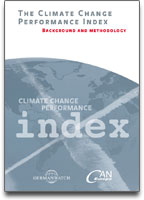 In December 2010 Germanwatch and Climate Action Network (CAN) Europe released the sixth annual Climate Change Performance Index (CCPI), which evaluates and ranks the 57 highest-emitting countries based on their emissions and climate policies. Canada placed 54th out of 57 countries, ahead of only Australia, Kazakhstan and Saudi Arabia. The survey consults 190 climate experts around the world and considers an analysis of national priorities, the strength of countries climate policies, and how well that country controls greenhouse gas emissions.
In December 2010 Germanwatch and Climate Action Network (CAN) Europe released the sixth annual Climate Change Performance Index (CCPI), which evaluates and ranks the 57 highest-emitting countries based on their emissions and climate policies. Canada placed 54th out of 57 countries, ahead of only Australia, Kazakhstan and Saudi Arabia. The survey consults 190 climate experts around the world and considers an analysis of national priorities, the strength of countries climate policies, and how well that country controls greenhouse gas emissions.It's the sixth year in a row Canada has been judged an international laggard, and placed near the bottom of the CCPI. For the 2010 report, Canada ranked 56th out of 57 countries evaluated. "Although Canada scored poorly across the board, its national policies were its greatest source of weakness. Sadly, that's not a surprise, as the federal government has failed to put in place the key policies needed to cut Canada's greenhouse gas pollution. It's worth noting that Norway — like Canada, a cold country that exports oil and gas — finished third overall, earning a high score on climate policy," stated Matthew Bramley, Director of the Pembina Institute's climate change program. View December 6, 2010 Gemanwatch, Climate Change Performance Index 2011View December 6, 2010 CBC article View December 6, 2010 Winnipeg Free Press (online) article View December 6, 2010 660 AM News (Calgary) article View December 6, 2010 Straight.com article View December 8, 2010 Troy Media article View Manitoba Wildlands Climate Change Meetings page Source: Germanwatch, CBC |
|
 Print version Print version |
Top |
| Mackenzie Pipeline Approved | 4 January 11 |
 The National Energy Board (NEB) gave the go-ahead for construction and operation of the Mackenzie Gas Project through Canada's North December 16, 2010.
The National Energy Board (NEB) gave the go-ahead for construction and operation of the Mackenzie Gas Project through Canada's North December 16, 2010.The $16 billion Mackenzie Gas Project encompasses: (i) development of three onshore natural gas fields in the North West Territories (NWT) which pose a direct threat to a migratory bird sanctuary, endangered wildlife species and hundreds of streams and rivers; (ii) a 457-kilometre pipeline to carry natural gas liquids from Inuvik, Northwest Territories (NWT) to an existing oil pipeline at Norman Wells, NWT; and (iii) a 1,196-kilometre long Mackenzie Valley Pipeline which would run from the Beaufort Sea to northwestern Alberta carrying up to 34.3 million cubic metres (1.2 billion cubic feet) of natural gas per day to be used to power growing oil sands production. The license application was filed in 2004 and the NEB began hearing evidence in January 2006. Final arguments were completed April 2010. In total, the Board held hearing sessions over 58 days in 15 communities throughout the Northwest Territories and Northern Alberta. More than 200 individuals and organizations participated in the NEB's hearing. The NEB attached 264 conditions that must be met for any federal permits and licenses. The project still requires Cabinet approval from the Canadian Federal Government. The Mackenzie Gas Project has benefit and access agreements in three regions with the Inuvialuit, the Gwich'in and the Sahtu Dene. There is no agreement with the Dehcho who occupy 40 per cent of the land the proposed pipeline will go through in the southwest North West Territories. "Canada is once again violating an agreement with our people and trying to open sensitive lands to industrial development. We'll fight them every step of the way," said Dehcho Grand Chief Samuel Gargan. View December 16, 2010 National Energy Board press releaseView National Energy Board "Reasons for Decision" page View National Energy Board "Mackenzie Gas Project" page View December 16, 2010 Ecojustice press release View December 16, 2010 Winnipeg Free Press article View December 16, 2010 CBC article View December 16, 2010 CBC backgrounder View December 16, 2010 Globe and Mail article View December 17, 2010 Sierra Club of Canada press release View December 22, 2010 Journal of Commerce article Source: National Energy Board, Journal of Commerce |
|
 Print version Print version |
Top |
| Royal Society of Canada Oilsands Report | 20 December 10 |
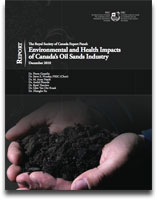 "Today the scientists of the Royal Society of Canada confirmed that there are many serious gaps in the environmental assessment, regulation and monitoring of Canada's oilsands industry," said Pembina Institute Policy Director Simon Dyer following the release of an expert report Environmental and Health Impacts of Canada's Oil Sands Industry.
"Today the scientists of the Royal Society of Canada confirmed that there are many serious gaps in the environmental assessment, regulation and monitoring of Canada's oilsands industry," said Pembina Institute Policy Director Simon Dyer following the release of an expert report Environmental and Health Impacts of Canada's Oil Sands Industry."If we were to stop oilsands mining tomorrow, we would still have an issue that was going to be associated with water -- both from the tailings ponds and from the potential threats on groundwater -- for many decades to come," said aquatic toxicology specialist and report co-author University of Guelph professor Glen Van Der Kraak. The report is critical of industry and government and calls for increased monitoring and more rigorous scientific oversight. But it also dismisses any correlation between oil sands pollution and an elevated cancer rates in Fort Chipewyan, a Mikisew first nations community in Northern Alberta. "All the studies that we've been conducting and all the information that we've been receiving states that there is something wrong. What about cumulative effects, after long periods of time?" responded Chief Allan Adam of the Athabasca Chipewyan First Nation. "We strive strongly for balance, not for sensationalism. For me, the take-home message of the report is we have very strong failures in our regulatory and oversight system, both at the federal and provincial levels. That needs urgent attention," said William Leiss, report co-author and a University of Ottawa professor. View December 15, 2010 Royal Society of Canada report (PDF)View December 15, 2010 Pembina Institute press release View December 15, 2010 Globe and Mail article View December 15, 2010 Edmonton Journal article View December 16, 2010 Calgary Herald article View December 16, 2010 National Post article View Sierra Club Canada Response to Royal Society of Canada Report View December 15, 2010 Sierra Club Canada article View Manitoba Wildlands Addressing Climate Change page Source: Royal Society of Canada, Pembina Institute |
|
 Print version Print version |
Top |
| Manitoba Corporate Welfare for Tembec | 20 December 10 |
 In her 2010 Report to the Legislative Assembly - Performance Audits Auditor General of Manitoba, Carol Bellringer criticizes Manitoba's allocation of $3 million in federaleco-trust funding to Tembec. The eco-trust funding was provided to provincial governments by the Canadian federal government to fund initiatives that reduce greenhouse gas (GHG) emissions. Manitoba received $53.8 million in funding through the eco-trust program intended to support projects that reduce GHG emissions.
In her 2010 Report to the Legislative Assembly - Performance Audits Auditor General of Manitoba, Carol Bellringer criticizes Manitoba's allocation of $3 million in federaleco-trust funding to Tembec. The eco-trust funding was provided to provincial governments by the Canadian federal government to fund initiatives that reduce greenhouse gas (GHG) emissions. Manitoba received $53.8 million in funding through the eco-trust program intended to support projects that reduce GHG emissions.In 2001 Tembec upgraded it's Pine Falls operations, with a resulting decrease in coal use and correspondingly emissions. However it was not until 2008 that the $3 million was given to Tembec, so the funding provided no net reductions in GHG emissions. As Bellringer explains, contrary to government spin, this funding was not meant to reduce emissions, "...[the] case for this funding was built primarily on economic reasons... in response to concerns over the pending closure of the [Pine Falls, MB] plant." With the mill closed and no net reductions in emissions, Manitobans gained little from this funding. Nor was this the only funding provided to Tembec before the mill closed down in September 2009. When the Manitoba Government announced an end to logging in provincial parks in December 2008 it also announced: "[a] total of just over $3 million in one-time financial compensation will be paid to Tembec and Tolko to reflect the cost of moving operations out of parks." None of the parklands where logging stopped have restoration plans or new regulations to protect these zones. It remains unclear whether Tembec was obligated to pay any of this government funding back upon closure. Even though the Tembec plant was closed Manitoba Conservation moved forward with review of a new twenty-year (2009-2028) Environmental Impact Statement (EIS) and Forest Stewardship Plan (FSP) in January 2010. Manitoba Wildlands submitted comments on the proposed EIS and FSP. View December 2010 Office of the Auditor General of Manitoba report (PDF)View January 11, 2010 Manitoba Wildlands comments (PDF) View Tembec online public registry file #4572 View November 21, 2008 Manitoba Government news release View March 3, 2007 Joint Canada/Manitoba press release View Manitoba Wildlands Manitoba Forest Companies & Tenure page Source: Office of the Auditor General of Manitoba |
|
 Print version Print version |
Top |
| Canadian Environment Commissioner says Environmental Issues Hindered | 14 December 10 |
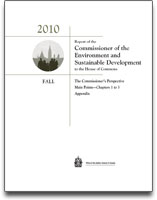 Scott Vaughan, Canadian Commissioner of the Environment and Sustainable Development, examines three topics in details in his 2010 Fall Report:
Scott Vaughan, Canadian Commissioner of the Environment and Sustainable Development, examines three topics in details in his 2010 Fall Report:
"Canada still does not have a national plan to ensure the federal government is ready to respond to major incidents involving spills from vessels transporting all kinds of hazardous and noxious substances. The Canadian Coast Guard has unclear, incomplete, and unreliable data about oil spill responses, and cannot accurately determine the actual size of spills, how many spills required onsite responses, how many spills required the use of Canadian Coast Guard equipment, and the results of the cleanup efforts," says the Commissioner Vaughn's report. "Environment Canada has been running the federal water quantity and water quality monitoring programs for about 40 years without knowing who - if anyone - is monitoring the quality of fresh water on federal lands," the report highlights, noting Environment Canada has water quality monitoring stations on only 12 of some 3,000 First Nation reserves. The report recommends Environment Canada take the lead in a coordinating a government-wide response to climate change. This would include the sharing of tools and best practices "to improve how the government integrates climate-risk identification, assessment and adaptation into its decision making and planning." View December 7, 2010 Office of the Auditor General of Canada press releaseView Fall 2010 Office of the Auditor General of Canada report View December 9, 2010 Globe-net article View December 7, 2010 The Globe and Mail article View December 8, 2010 Vancouver Sun article Source: Office of the Auditor General of Canada, Globe-net |
|
 Print version Print version |
Top |
| Polar Bears Starving to Death in Hudson Bay | 14 December 10 |
 Dramatic new video footage shows the dire consequences of climate inaction for polar bears. The video, shot on November 23, 2010 on the western shores of Hudson Bay in Manitoba, Canada, shows an undernourished polar bear mother and her two starving cubs struggling to survive. One of the cubs experiences seizures in the video, and both cubs died within two days of the filming.
Dramatic new video footage shows the dire consequences of climate inaction for polar bears. The video, shot on November 23, 2010 on the western shores of Hudson Bay in Manitoba, Canada, shows an undernourished polar bear mother and her two starving cubs struggling to survive. One of the cubs experiences seizures in the video, and both cubs died within two days of the filming."Such events can only become more frequent in the future because increased greenhouse gas levels guarantee that the climate will continue to warm, and a warmer world means less sea ice-in Hudson Bay and elsewhere. Scientists have projected that polar bears could disappear entirely by the end of the century if greenhouse gas emissions are not reduced," said Dr. Steven Amstrup, Polar Bear International's senior scientist. Polar bears are completely dependent upon large expanses of sea ice to hunt, feed and survive. They use the sea ice as a platform to capture seals and other prey. Polar bears in western Hudson Bay must come to land each spring when the sea ice melts. While onshore the bears fast until the ice freezes again losing up to 30 percent of their body mass. Twenty years ago, the average date the bears returned to the ice was November 8. A decade ago that date stretched to November 20. In 2009 the bears returned to the ice on approximately December 4, and in 2010 the bears begun to return to the ice around December 7. The western Hudson Bay polar bear population declined 22 percent between 1987 and 2004. If current trends persist it will likely be the first polar bear population driven extinct by global warming. Watch Nature Exposures video Mother Polar Bear Loses Her Two One Year Old Cubs Most Likely to StarvationView December 7, 2010 Polar Bears International press release (PDF) View December 8, 2010 Center for Biological Diversity press release View December 8, 2010 Common Dreams article Source: Polar Bear International, Center for Biological Diversity |
|
 Print version Print version |
Top |
| Cancún Creates Hope for Durban | 14 December 10 |
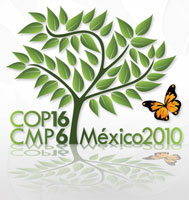 "Confidence is back. Hope has returned!" exclaimed Mexican President Felipe Calderon at the conclusion of the Cancún Climate Conference. Delegates meeting at the 16th Conference of the Parties to the UN Framework Convention on Climate Change (UNFCC), representing 193 countries, overcame deep suspicion and geopolitical rivalries, approving the Cancún Agreements which commit countries to increase their effort to battle climate change and preserves key principles of the Kyoto Protocol. "With this agreement, we have broken out of the inertia and feeling of hopelessness," added Calderon.
"Confidence is back. Hope has returned!" exclaimed Mexican President Felipe Calderon at the conclusion of the Cancún Climate Conference. Delegates meeting at the 16th Conference of the Parties to the UN Framework Convention on Climate Change (UNFCC), representing 193 countries, overcame deep suspicion and geopolitical rivalries, approving the Cancún Agreements which commit countries to increase their effort to battle climate change and preserves key principles of the Kyoto Protocol. "With this agreement, we have broken out of the inertia and feeling of hopelessness," added Calderon.Achievements of the climate conference include:
"Today's result chases away many of the ghosts of Copenhagen. Although the result is very far from perfect, the Cancun climate talks took real steps forward, including establishing a new global climate fund. Unfortunately Canada was singled out as a laggard among its peer countries, particularly on the question of the second phase of Kyoto," said Pembina Institute Policy Analyst Clare Demerse. The next Conference of the Parties to the UNFCCC is scheduled for Durban South Africa from 28 November to 9 December 2011. View Cancún Agreements on UNFCC webpageView December 11, 2010 The Globe and Mail article View December 11, 2010 United Nations press release View December 11, 2010 Climate Action Network release View December 13, 2010 New York Times article View Manitoba Wildlands COP16 page Source: United Nations, The Globe and Mail, Climate Action Network |
|
 Print version Print version |
Top |


 RSS Feeds:
RSS Feeds: